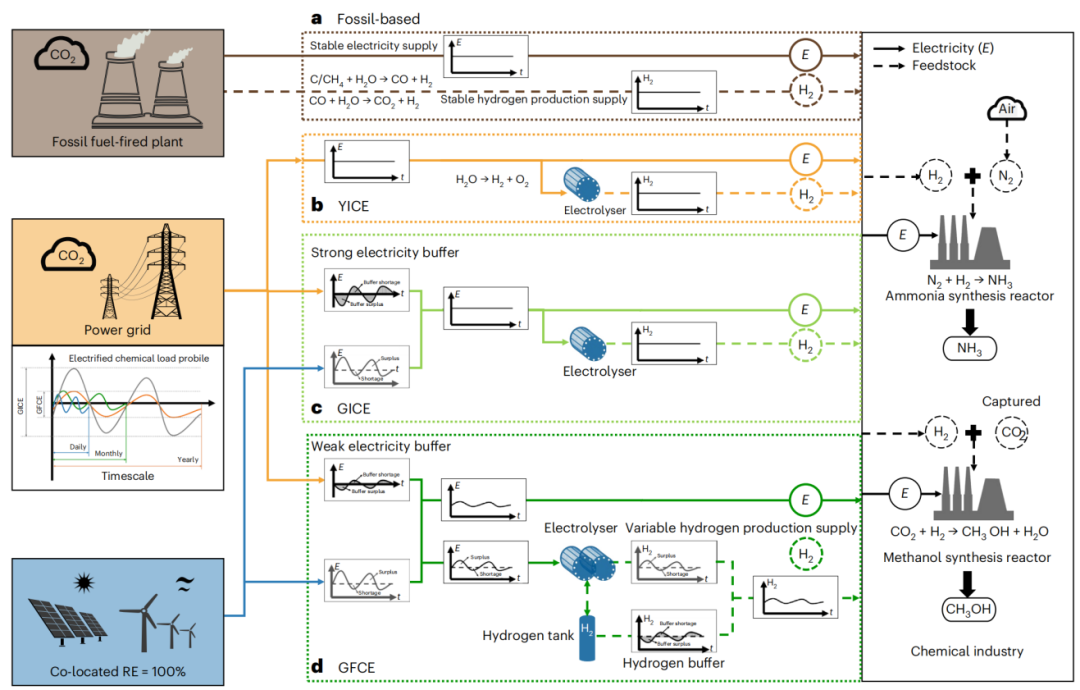The chemical industry, especially ammonia and methanol production, remains a major challenge in achieving carbon neutrality due to its significant carbon footprint. An interdisciplinary research team from Tsinghua University’s Institute for Carbon Neutrality has proposed a innovative solution—the Green Flexible Chemical Electrification (GFCE) pathway. Published in Nature Energy under the title "Redesigning electrification of China’s ammonia and methanol industry to balance decarbonization with power system security," the study introduces a deep-coupling approach between the power system and green hydrogen-based chemical production, enabling synergistic carbon reduction through direct connection of renewable electricity.
The Challenge and Opportunity for Decarbonizing the Chemical Industry
In China, ammonia and methanol production heavily relies on coal, resulting in high carbon emission intensities due to the high carbon and low hydrogen content of coal. Achieving deep decarbonization without compromising production safety is an urgent priority.
A Novel Approach: Electricity-Hydrogen Synergy
Current electrification strategies largely depend on grid power, which may shift emissions from the chemical to the power sector, potentially increasing overall national emissions. The GFCE pathway addresses this by establishing an integrated system directly powered by renewable electricity, combined with advanced hydrogen-ammonia-methanol coupling control and dispatch technologies. This enables deep electrification of chemical processes while reducing emissions in both chemical and power sectors. Moreover, it mitigates grid impact and enhances power system security through optimized electricity-hydrogen coordination.

Key Technologies and Analytical Framework of the GFCE Pathway
The GFCE pathway emphasizes two core attributes: "green" and "flexibility." "Green" refers to the use of direct renewable electricity as a zero-carbon feedstock, enabling emission reduction at the source. "Flexibility" involves the adaptive operation of the electricity-hydrogen system, buffering the intermittency and variability of renewables and balancing energy supply and demand across time scales.
To evaluate the GFCE pathway comprehensively, the team developed an integrated analytical framework covering carbon emissions, power system security, and economic performance. The framework incorporates two core models:
A Chemical-side Capacity Planning and Flexible Operation (CP&FO) model, which dynamically plans capacities for renewables, electrolyzers, and hydrogen storage based on industrial test data and process simulations.
A Power-side Economic Dispatch and Unit Commitment (ED&UC) model, which optimizes national economic dispatch and provincial unit commitment while accounting for chemical load fluctuations.
The study also built a detailed database covering chemical and power systems in 22 Chinese provinces, including renewable resource distribution, chemical production loads, and transmission networks.
Performance and Advantages of the GFCE Pathway
Simulations across 22 provinces indicate that by 2030, the GFCE pathway will be economically competitive nationwide, with green ammonia production potentially achieving cost advantages over gray ammonia. Optimized electricity pricing mechanisms can further enhance synergies between the power and chemical sectors through flexible demand management.
Long-Term Trends and Policy Recommendations
As renewable penetration increases in both power and chemical sectors, the GFCE pathway is expected to achieve greater carbon reduction and economic benefits. By 2050, it could be widely adopted, enabling deep decarbonization of the chemical industry. The research team recommends policy support such as subsidies or carbon taxes in provinces with higher green production costs, alongside improved electricity pricing mechanisms to guide chemical production loads in a grid-friendly manner.
Conclusion
The GFCE pathway offers a groundbreaking solution for integrating renewable energy and decarbonizing ammonia and methanol production. By directly coupling renewable electricity with green hydrogen chemical processes, it significantly reduces emissions while enhancing grid stability, supporting China’s carbon neutrality goals. This work builds on long-term research in green hydrogen-ammonia-methanol systems and key equipment by Tsinghua’s Department of Electrical Engineering and the Sichuan Energy Internet Research Institute.
The paper features Ji-Rong Li (Tsinghua/Harvard postdoc), Jin Lin (Tsinghua), and Jianxiao Wang (Peking University) as co-first authors; Jin Lin, Jianxiao Wang, and Xi Lu (Tsinghua) as corresponding authors. Collaborators include Michael B. McElroy and Chris P. Nielsen (Harvard China Project), Yonghua Song (University of Macau), Jie Song (Peking University), Xuefeng Lyu (North China Electric Power University), and others. The research was supported by the National Key R&D Program of China, the Carbon Neutrality and Energy System Transformation (CNEST) Program, the National Natural Science Foundation of China, and the Energy Foundation China.
Article Link:
https://www.nature.com/articles/s41560-025-01779-9
DOI: 10.1038/s41560-025-01779-9
 Latest recommendations
Latest recommendations


